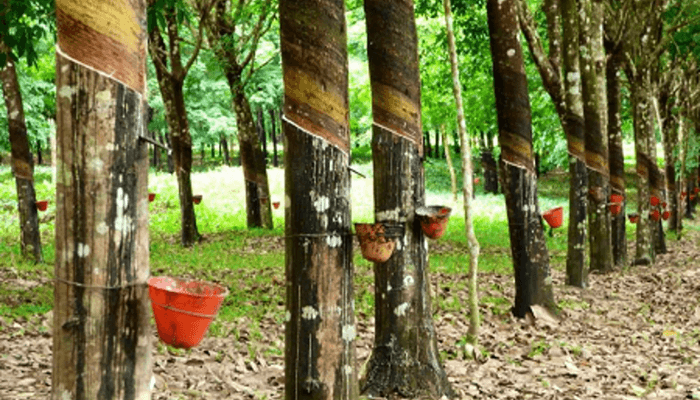Aging rubber trees cost Nigeria $65bn opportunity
Nigeria is missing out on a multi-billion-dollar global rubber market as aging plantations and inconsistent policies continue to hold back the sector’s growth, experts warn.
Once Nigeria’s fourth-largest foreign exchange earner, the natural rubber industry is now in decline as aging plantations and weak policies drag output.
Raw material shortages have driven up import dependence and production costs, forcing many factories to shut down while the few still operating run below 60 percent capacity, BusinessDay findings show.
According to the Rubber Research Institute of Nigeria (RRIN), decades of weak policy frameworks and aging plantations have slashed output, limited supplies, and increased the country’s dependence on imports.
“Nigeria’s rubber sector is hugely underexploited because of the absence of a well-developed policy. This underdevelopment costs the country about N2 trillion annually,” said Lelia Dongo, executive director of RRIN.
In 2023, Nigeria exported 39,168 tons of natural rubber worth $58 million, an 8.6 percent decline from 2022, according to the World Trade Data. By contrast, the country imported $293 million worth of rubber during the same period, highlighting a deep production gap.
“Existing plantations are over 40 years old and should have been replanted. With regenerated bark tapped several times, yields will only decline,” said Peter Igbinosun, president of National Rubber Producers, Processors and Marketers Association of Nigeria (NARPPMAN)
Industry experts insist replanting is urgent. “Aging plantations have exceeded their economic lifespan and must be replaced,” said Abolagba Ebenezer, director of research at RRIN.
Isiaka Bakare, head of Knowledge Management at the institute, confirmed that over 300 hectares of RRIN’s own plantations are aging, further weakening domestic output.
Timothy Esekhade, research director at RRIN, noted other challenges stalling growth in the sector, citing “poor funding, high input costs, insecurity, farm vandalism by locals seeking profits, and land access issues.”
Facts and figures
Nigeria’s rubber exports plunged by 76 percent between 2009 and 2019, while imports jumped 106 percent over the same period, according to International Trade Data and BusinessDay research.
Despite having more than 18 million hectares of land suitable for rubber cultivation across 24 states, only about 167,000 hectares are in use—much of it past peak productivity.
Globally, the outlook contrasts sharply. The rubber market, valued at $46.95 billion in 2023, is projected to reach $65.65 billion by 2030.
With global production expected to grow by just 0.3 percent in 2025 against a 1.8 percent rise in demand, the supply gap is widening, data from the Association of Natural Rubber Producing Countries (ANRPC) show.
For Nigeria, this gap signals both a missed opportunity and a potential goldmine. By leveraging its favourable climate, abundant labour, expanding automotive industry, and emerging medical sector, the country could reposition its rubber industry for strong growth and renewed global relevance.
Planting rubber: costs, yields, market potential
Experts say that once land is secured, 70 percent of the challenges in rubber farming are solved. Planting a hectare of rubber now costs about N8.6 million, according to NARPPMAN.
At the recommended planting distance of 6.6m by 3.3m (FAO standard), one hectare accommodates roughly 450 seedlings, each priced between N400 and N500. Additional inputs such as fertilizers and pesticides are also required, as rubber thrives best in well-drained tropical soils. The most preferred variety is Hevea brasiliensis due to its high yields.
Read also: Rubber imports jump 106% as production stalls
“Planting should be done between June and July on acidic soils with a pH of about 4.5,” advised farmer Eno Johnson. Seedlings can be sourced from the Rubber Research Institute of Nigeria in Edo State or smallholder breeders nationwide.
Rubber trees mature in five years–seven years, after which tapping can begin. “You know the plant is ready when you measure 100cm up from the base and 50cm around the trunk’s circumference,” explained Emmanuel Ofori, an experienced rubber farmer.
On average, one hectare yields about 1,000kg of rubber monthly. At the current market price of N1,300 per kg, farmers can earn between N13 million and N15 million per metric ton annually, according to Igbinosun (earlier mentioned).
“ Rubber is an everyday business, and once you harvest, the market is readily available,” noted Esekhade, earlier quoted. “You can sell to factories, off-takers or exporters. Beyond production, farmers can triple profits through value addition,” according to reports by Africa Today.
With uses ranging from tyres, tubes, gloves, and condoms to erasers, adhesives, clothing, and coatings, natural rubber remains a vital global commodity. For Nigeria, it represents not only a pathway to diversify exports but also a multi-billion-naira investment opportunity.
Global market
The global rubber market size was estimated at $46.95 billion in 2023 and is projected to reach $65.65 billion by 2030, growing at a CAGR of 5.08 percent from 2024 to 2030, according to the Grand Review Research.
Thailand, Vietnam, Indonesia and Ivory Coast are the leading producers globally. Nigeria is the second leading producer in Africa and 12th globally.
Recovery strategies
Experts say Nigeria’s rubber sector can recover with two urgent interventions: robust, investor-friendly policies and investment in early-maturing rubber seedlings.
Dongo, earlier quoted, said “a robust and investor-friendly policy can spur growth, create jobs, and boost food security.”
Ebenezer Abolagba, RRIN’s director, Research, also urged increased research and development funding to produce early-maturing seedlings and access to affordable credit, warning that the current long-gestation rubber varieties have become a disincentive to investors.
“Early-maturing varieties could attract more investment, as the long gestation period of six to eight years discourages investors,” he noted
“The current variety of rubber seedlings have been a disincentive to investors in the rubber value chain. It is important to fund research institutes and grant access to low credit facilities to boost our chances of producing early-maturing seedlings,” he said.

